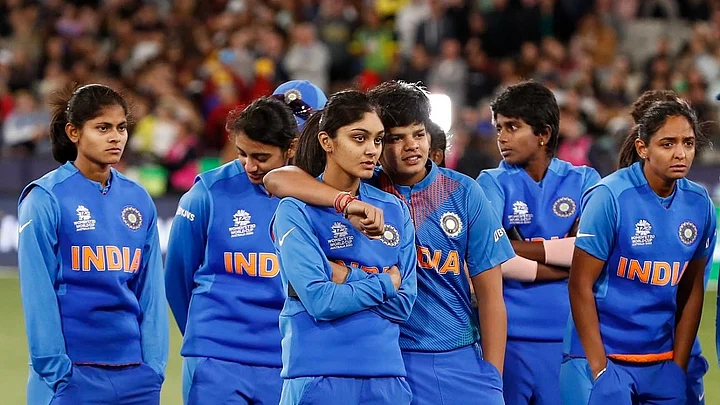Equal or better pay for women athletes has, over decades, been an uncomfortable conversation for administrators across sports. A sense of balance has only been achieved when a stand has been taken, as was seen in the cases of the US football team and Megan Rapinoe, Serena Williams, the Australian women’s cricket team and Billie Jean King.
On Wednesday, 19 May, as the Indian women’s cricket team, non-Mumbai based members, began their quarantine ahead the England tour, the BCCI announced the annual central contracts, chopping down the list from 22 to 19, for the period, October 2020-September 2021.
While players like Veda Krishnamurthy and Ekta Bisht missing out on central contracts did raise a few eyebrows, it was the glaring difference in pay, when placed alongside the men’s team, that has raised concerns. Do note, the richest cricket board in the world introduced the contract system for the women’s team only in 2015 when Shashank Manohar was President.
BCCI President Sourav Ganguly has vowed to push women's cricket during his tenure and the Secretary Jay Shah promises commitment, but despite that, it's seemingly up to the players to help themselves — this after reaching the 50-over World Cup final in 2017, a semi-final appearance in the 2018 T20 World Cup, and a runner-up finish in the 2020 T20 World Cup.
The payment bracket for men is currently set at Grade A+ (INR 7 crore), A (INR 5 crore), B (INR 3 crore), and C (INR 1 crore). The scales for the women are Grade A (INR 50 Lakh), Grade B (INR 30 Lakh) and Grade C (10 Lakh). The BCCI pays the top Indian women’s cricket player lesser than a male cricketer with the lowest-level Grade C contract.
The men’s contracts, meanwhile, were announced on 15 April and the women had to wait for almost five more weeks to hear about theirs.
Why the Disparity?
In a press conference in January 2020, India’s Smriti Mandhana touched upon the issue, saying that the team needs to earn more revenue.
“We need to understand that the revenue we get is through men's cricket. The day women's cricket starts earning revenue, I will be the first person to say that we need the same thing. I don't think any of my teammates are thinking about this (pay) gap because the only focus right now is to win matches for India, get the crowd coming in and earn revenue.” the left-handed batter had said.
If revenue from the sport is the reason for the disparity, then the question is, who is responsible for ensuring that the game reaches the masses? Is it the players or the administrators? The buck stops with the administration, who in India, have seemingly found it extremely difficult to plan games for the women’s team — at a time when the IPL and the Women’s T20 Challenge was followed up with a full tour of Australia and a visit by England for the men’s team, and those are just the fixtures where India was involved.
If performance is the other criteria, then it is even more imperative that the women’s team receives a significant hike in pay, as they have reached as many ICC tournament finals in the last four years as the men have since 2014.
Remember, the last time the players got a hike was in 2018.
Where Do the Other Top Nations Stand?
In terms of treating their players better, Cricket Australia has led from the front. In 2016, they ensured the women’s team got the same treatment at the T20 World Cup in India. The following year, they increased wages for the women’s team by more than 100% and both genders get equal pay as received by their male counterparts in terms of the revenue sharing model.
Furthermore, CA promised, for the 2020 T20 World Cup, to top up whatever money their women's team would win from ICC to ensure parity with the men's prize money.
What pushed Cricket Australia into the move for an improved pay scale was the united front the cricketers put up, led by the the Australian Cricketers’ Association.
In England, the cricket board has more than 40 players on central contracts. Since 2017, cricket has made the biggest moves in terms of gender parity, according to a study by BBC in March 2021. That apart, the ECB’s new tournament, The Hundred, will feature equal prize money for the men’s and women’s competitions. The organisers said the total prize budget of £600,000 ($769,000, 689,000 euros) would be split fifty-fifty between the women’s and men’s competitions as part of the governing body’s “commitment to making cricket a gender-balanced sport”.
What Next?
More often than not, the BCCI has fallen short when it comes to treating the women’s team with respect, and the sluggish approach needs to change. The delayed team announcements for the recently completed South Africa series and the much-rushed process of appointing Ramesh Powar as Head coach, replacing WV Raman reeks of an unprofessional attitude.
Not to forget, the immaculately planned Women’s T20 Challenge, which clashed with the Women’s Big Bash League last year, causing marquee players to miss out.
Undoubtedly, the women’s team is more than eligible for a bump up in their contracts and their fixtures deserve more of the spotlight.
Women’s cricket in India needs a dedicated administrative approach and that is the only way to display ‘commitment’. While Sourav Ganguly can truly step up and set an example, yet again, for more of Indian cricket to follow, the likes of Smriti Mandhana must take the chance and rock the boat, much like the current T20 Women’s World Champions.
From better live coverage to more sponsors, to more matches for the national team, and finally more of the pie, the onus is squarely on the administration because those wearing the India cap are there specifically to play cricket.
